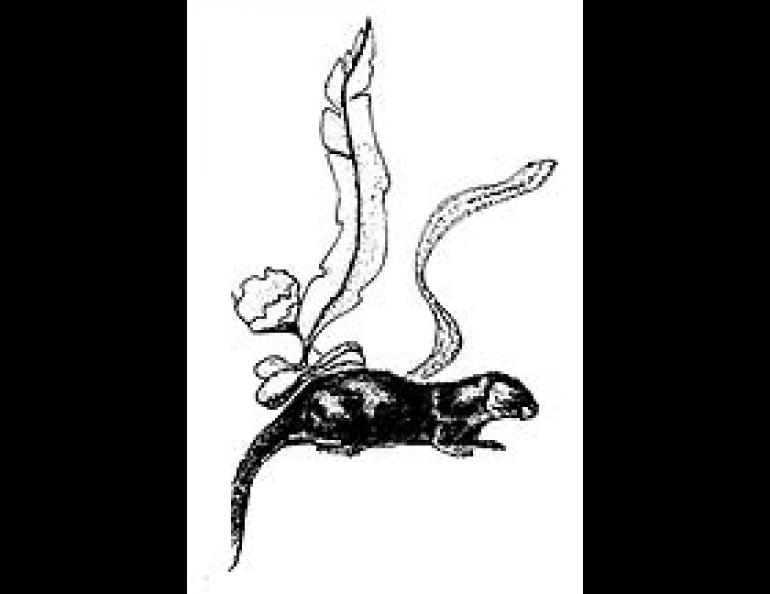
Scientists Show Kelp Helps--with a Little Help from their Friends
Kelp and other big seaweeds grow along North America's rocky Pacific coasts from California to the Aleutians. Although few sea creatures graze on kelps directly, marine biologists did have good evidence for seaweed's value in the multi-step food chains supporting ocean life. Now, thanks to a clever experiment in the Aleutians, the evidence is specific--and very convincing.
In a way, sea otters helped the scientists. In their slow return from the brink of extinction, the animals have recolonized only portions of their old range. Where otters live, underwater kelp beds are likely to be thick and healthy, because otters eat great quantities of sea urchins. Some sea urchins' favorite food is kelp, and the prickly urchins can eat away whole beds of the big algae. Where otters have not returned, the urchins abound, and the heavily grazed kelp beds are sparse.
The scientists, D.O. Duggins and C.A. Simenstad of Washington state and J.A. Estes from California, reported their work in Science magazine. They realized the otters had created a natural laboratory for comparing the productivity of nearshore areas with and without kelp. They selected Shemya and Alaid-Nizki for their otter-free, low-kelp study sites. Adak and Amchitka provided kelp-rich comparisons.
Research sites at all four islands had similar oceanographic conditions, and nearly identical plant species (including free-floating tiny phytoplankton). The only significant difference was that Adak and Amchitka had far greater supplies of healthy kelps.
The experiment had two parts. The first compared growth of suspension-feeding organisms in the presence and absence of big kelp beds. On each island the researchers set out cages of barnacles and mussels at a dozen locations, half in subtidal areas where the animals were always under water, and half at intertidal sites, where they dried out at low tide. The animals were measured carefully when they were put in the cages and again a year later.
The barnacles in subtidal cages died, but all the other animals grew--and grew much better where there were kelp beds. Mussels in kelp-dominated environments grew two to four times as fast as those in urchin-dominated places, and the intertidal barnacles grew as much as five times faster when they lived in waters with healthy kelp stands.
That seemed to be a strong vote for kelp's importance to the food chain, but it wasn't definitive. Clearly the barnacles and mussels weren't getting out of their cages to chew up kelp fronds directly. Whatever benefit they got from the big algae was indirect. Apparently they were filtering organisms from the water that had eaten something provided by the kelp, either dissolved organic matter exuded by growing plants or solid particles washed from old, dying, or dead plants.
But "apparently" isn't good enough. The experiment showed the filter-feeding test animals grew better in kelp-dominated areas, but it didn't show why they grew better. The scientists still had to prove that kelp rather than phytoplankton was the ultimate source of food for the barnacles and mussels. To do that, they turned to isotopic measurements.
Not all carbon is created equal. Nearly all of it has the atomic mass number of 12; the heavier carbon 14 is radioactive. In between is another, nonradioactive, isotope of carbon: carbon 13. During photosynthesis, when a plant fixes carbon (that is, incorporates the element permanently into its tissues), it takes in a certain proportion of carbon 13. The ratio of carbon 12 to carbon 13 is distinctively different between different kinds of marine plants; kelps are considerably enriched in carbon 13 compared to phytoplankton.
So is everything that eats kelp, and in turn so is everything that eats something that ate kelp. Carbon 13 is what biologists call a conservative tracer. The signature ratio can be followed so clearly up the food chain that an isotope analysis of a bear steak can tell the hunter how much of the bruin's diet came originally from a kelp bed.
In the case of the fast-growing mussels and barnacles, the signature was very clear. When the scientists checked other organisms in the bays of Amchitka and Adak, they found the same kelp-based ratio of carbon 13 to carbon 12. Whatever else the sea life was eating, the kelps provided the main course--and a hearty one at that.





